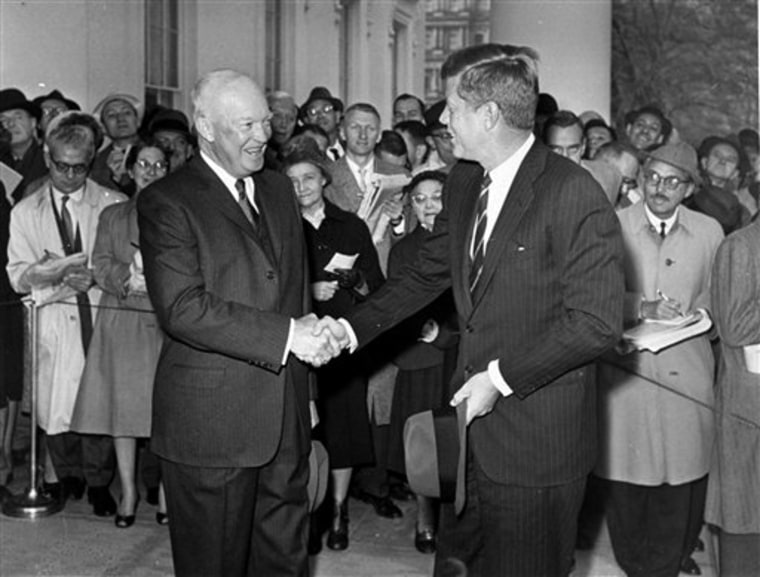The first meeting of incoming and outgoing presidents has been a rite of passage fraught with emotion, surprises and the rare exchange of secrets between leaders of opposite political parties.
On Monday, President Bush welcomed President-elect Obama to the White House, and the 43rd and 44th presidents made nice, chatting amiably as they strolled down the Colonnade and waving for the cameras before they disappeared inside for a one-on-one meeting. This, after a hard-fought campaign in which one of Obama's most effective strategies was to rail against the "failed policies" of the current president.
It's often an emotional moment for both the incoming and outgoing presidents. Although the formal transfer of power is still more than two months away, the "psychological transfer occurs then," former Vice President Walter Mondale once said.
As significant as the first meeting can be, it isn't even mentioned in the Constitution or federal law, so there are no rules governing how to do it.
Putting Campaign '08 in the rearview mirror, "Bush will turn on his boyish charm, and I think he's enough of a political pro not to take the campaign criticism seriously," said presidential historian Leo Ribuffo of George Washington University.
As for past meetings between once and future presidents, Ribuffo said, "they've been bad, and they've been good and they've been in the middle."
One of the most analogous transfers of power to the Bush-Obama transition occurred when 70-year-old Dwight Eisenhower, a Republican, made way after two terms for 43-year-old John F. Kennedy, a Democrat whom the president had derided as a "young whippersnapper" and "this young genius."
After the three-hour meeting, an aide later described Eisenhower as "overwhelmed by Sen. Kennedy, his understanding of the world problems, the depth of his questions, his grasp of the issues and the keenness of his mind."
It wasn't all about weighty matters of policy, though.
Eisenhower also took time to show Kennedy how to use the panic button that would bring a helicopter to the back lawn. Eisenhower demonstrated its use, and "Kennedy watched the fluttering helicopter coming down outside the windows within a few minutes," Kennedy aide Kenneth P. O'Donnell later wrote.
When Republican Richard Nixon arrived to meet with departing Democratic President Johnson, the two plunged into deep conversation about the Vietnam War and the social unrest gripping the country.
"On that day our political and personal differences melted away," Nixon wrote in his memoir. "As we stood together in the Oval Office, he welcomed me into a club of very exclusive membership, and he made a promise to adhere to the cardinal rule of that membership: stand behind those who succeed you."
As they walked to one in a series of White House meetings, Johnson pulled Nixon into his bedroom, and told him, "I wanted you to know about this." He showed Nixon a small safe hidden in the wall.
Bush, for his part, set the stage for an amiable meeting with Democrat Obama when he praised his election as "a triumph of the American story, a testament to hard work, optimism and faith in the enduring promise of our nation." Bush has promised to help make "America's first wartime presidential transition in four decades" as seamless as possible.
"I can't remember as generous a statement about a winner of the opposite party than that of Bush on the historic significance of Obama's win," said Fred Greenstein, a professor of politics at Princeton University.
While Bush and Obama met in the Oval Office, first lady Laura Bush was showing Michelle Obama around the first family's living quarters. Even before their meeting, the outgoing and incoming first ladies already had established the beginnings of a rapport. When Laura Bush defended Michelle Obama against campaign critics earlier this year, Michelle sent the first lady a note of thanks. She's praised the first lady for her "calm, rational approach."
Bush, the son of a president, was no stranger to the White House when he met with President Clinton in the Oval office for two hours as the president-elect in 2000. At the outset, Bush seemed tense, sitting straight in a wing-backed armchair, his hands clasped in his lap as he rubbed his thumbs and tapped his foot. Twice he thanked the president for his hospitality and said, "He didn't need to do this."
Not all meetings between once and future presidents have been a success — or even come to pass.
President Carter carefully prepared for his meeting with Ronald Reagan, according to Mondale, but "it all went over Reagan's head and Carter really was shaken by it."
Franklin Roosevelt "did not respond to overtures from the discredited Hoover," according to Greenstein. "He wanted to make a fresh start." As a result, Greenstein said, "Hoover was very chilly to him on the ride to the inauguration."
President Truman, who had the presidency thrust upon him without any transition period after Roosevelt's death, was eager to provide a smooth transition for his successor, Eisenhower. Truman arranged for troops to line both sides of Pennsylvania Avenue for Eisenhower's arrival.
Truman wrote later, "When the general and his aides left, I was troubled. I had the feeling that, up to this meeting in the White House, General Eisenhower had not grasped the immense job ahead of him."
